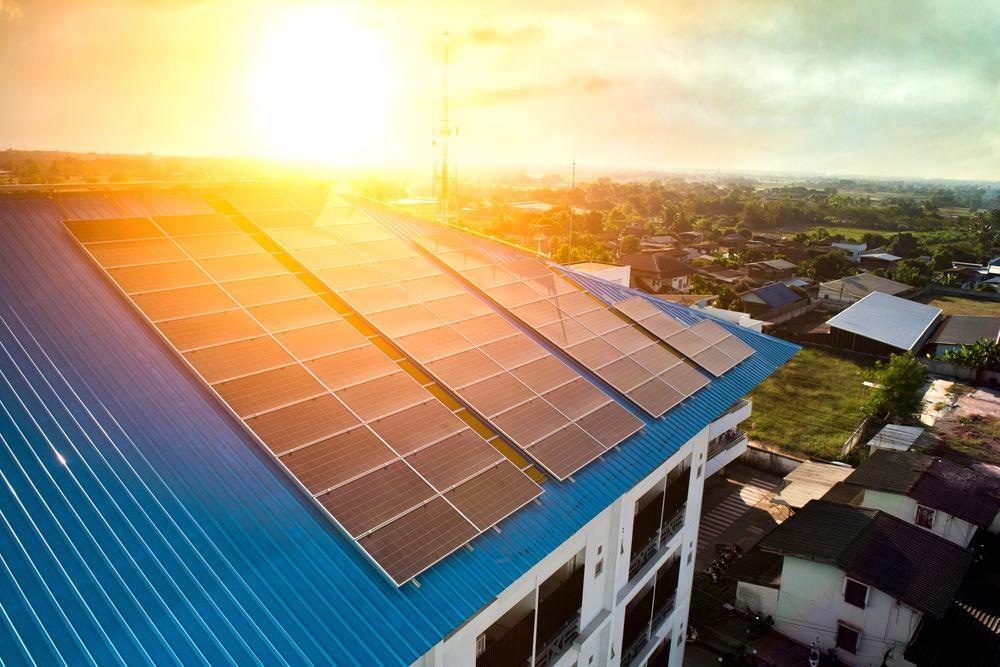 By Surbhi JainReviewed by Susha Cheriyedath, M.Sc.Feb 24 2022
By Surbhi JainReviewed by Susha Cheriyedath, M.Sc.Feb 24 2022In an article recently published in the journal Optical Materials, the researchers presented the utility of the double metal cladding waveguide technique towards the preparation of a perovskite solar cell with light trappers.

Study: Perovskite solar cell with light trappers fabricated by double metal cladding waveguide technology. Image Credit: Somchai_Stock/Shutterstock.com
Background
ABX3 (A = Organic cation, B = Metal cation, and X = Halide anion) has quite recently come up as a potential organic-inorganic hybrid perovskite (OHP) film material for solar cells. Low cost, wide light absorption range, ease of manufacturing, excellent carrier mobility, and long exciton diffusion length are some of the advantages of OHP.
Perovskite solar cells (PSCs) were first introduced in 2009 and have recently been found to have a high photoelectric conversion efficiency (PCE). PSC performance has been improved using a variety of approaches. Due to its significant absorption and scattering qualities of light, localized surface plasmon resonance (LSPR) is a novel technique utilized to improve the light absorption efficiency of the PSCs.
The LSPR effect increases the light absorption capability of the perovskite active layer when Au-NPs are included in the cell's cathode buffer layer. Au-NPs also boost charge transfer efficiency by shortening the lifetime of the carrier corresponding to the perovskite layer. Numerous ways for enhancing material optical absorption have been developed to date.
PCE, on the other hand, is constrained by a number of criteria. The majority of NPs are made using chemical processes and feature numerous surface imperfections that act as trapping centers.
About the Study
In the present study, the authors presented the development of PSCs using the double metal cladding waveguide (DMCW) technology wherein the chips were covered with hexagon-like nanostructures on the backside of Indium tin oxide (ITO) conductive glass. PSCs with various shapes of chips were studied for optical absorption and PCE. The absorption capacity of perovskite was matched by the LSPR of the chips. LSPR was utilized to improve the light energy scattering, gathering, and capture.
Using the DMCW approach, the light incident surface corresponding to the PSCs was covered with hexagon-like nanostructures. The DMCW had a better sensitivity, which facilitated coupling light between 600 and 800 nm into ITO glass.
A thin silver (Ag) layer (30 nm) was coated on the conducting surface of the 0.7 mm ITO glass slab for better coupling, but a comparatively thick Ag film (200 nm) was coated on the backside to prevent light energy loss. The guiding layer, coupling layer, and substrate, respectively, were ITO glass slab, thin Ag film, and thick Ag film. Through free-space coupling, a laser beam with a modest incidence angle to the coupling layer triggered the ultrahigh order modes.
Observations
In this study, the researchers observed that the properties of PSCs with chips were improved due to large absorption rates at long wavelengths after 600 nm in the ultraviolet-visible (UV–Vis) spectrum. The increase in the optical path of incident light and the light absorption capacity of the active layer caused the PCE and short circuit current density (Jsc) to increase by 27.21% and 6.78%, respectively.
More from AZoM: What is Femtosecond Laser-Based 3D Printing?
Furthermore, it was observed that the light energy was transformed into heat energy when it reached the thick Ag layer, which started the degradation of the substrate. At 0.1% HAuCl4, regular hexagonal arrays were observed, but not at lower concentrations. Nanostructures were also produced on the surface of the Ag film at a higher concentration (0.2%).
At 600 nm–800 nm, perovskite films showed good absorption capability, with a peak at 750 nm. Without the chips, the PSCs had the following characteristics: Voc = 0.89 V, Jsc = 17.70 mA/cm2, FF = 64.52%, and PCE = 10.16%. PSCs with optical trapping chips outperformed PSCs without them in terms of performance. The PCE of cells was enhanced by up to 13.37% when HAuCl4 was added.
The PCE of the perovskite cell with the chip (made by 0.1%) was 27.21% greater than that of the perovskite cell without the chip. LSPR was weaker, and PCE was lower when HAuCl4 concentration was larger than or less than 0.1%.
Conclusions
In conclusion, this study elucidated the potential of DMCW to cover polygon-shaped chips on the back of ITO glass for the development of PSCs. It was determined that by changing the Ag deposition time T and the HAuCl4 concentration, different chip architectures are created. This work demonstrated that the absorption capacity of perovskite matches very well with the LSPR of the chips.
The authors observed that the chips absorb incident light striking the perovskite layer, thereby increasing perovskite's optical absorption. They also illustrated that under 16-minute Ag deposition and 0.1 % HAuCl4, chips boosted the PCE of PSCs by 27.21%. The authors believe that this type of external modification has no effect on the intrinsic properties of perovskite metal, nor does it result in the early disposal of PSC structures.
Overall, the authors emphasized that the properties of PSCs with chips are improved due to substantial absorption rates at long wavelengths after 600 nm in the UV–Vis band.
Disclaimer: The views expressed here are those of the author expressed in their private capacity and do not necessarily represent the views of AZoM.com Limited T/A AZoNetwork the owner and operator of this website. This disclaimer forms part of the Terms and conditions of use of this website.
Source:
Wang, Y., Tang, J., Peng, C., et al. Perovskite solar cell with light trappers fabricated by double metal cladding waveguide technology. Optical Materials (125) 112091 (2022). https://www.sciencedirect.com/science/article/abs/pii/S0925346722001252